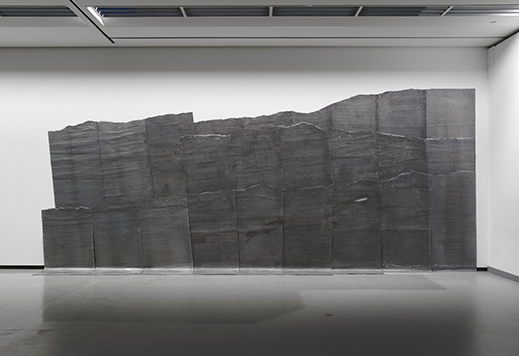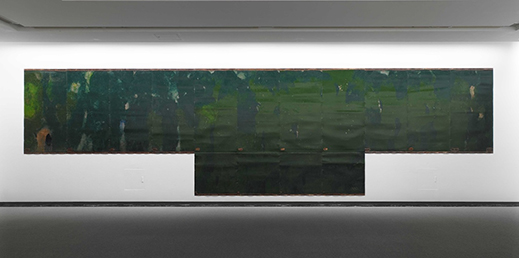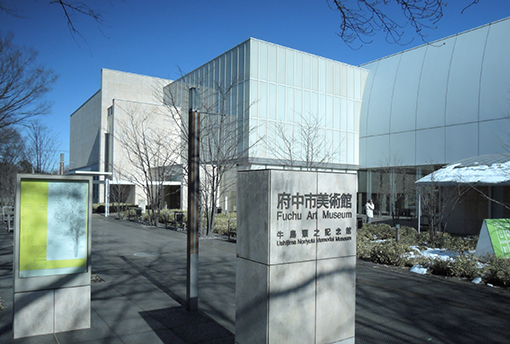 |
|
Here and There introduces art, artists, galleries and museums around Japan that non-Japanese readers and first-time visitors may find of particular interest. The writer claims no art expertise, just a subjective viewpoint acquired over many years' residence in Japan.
|
|
 |
|
|
 |
 |
Iron Man: Isamu Wakabayashi at the Fuchu Art Museum
Alan Gleason |
 |
|
Wakabayashi with Oscillating Scales (At Hand) (watercolor, pencil, paper) at the "Something Belonging to the Green in the Air" Exhibition, Gatodo Gallery, 1982; private collection. Photo: Yoshitaka Uchida |
A first encounter with the oeuvre of Isamu Wakabayashi (1936-2003) leaves one flailing for the words and concepts to makes sense of it. The multifaceted artist, best known for his work as a sculptor, was generous in articulating his aesthetic philosophy through numerous essays. But like many geniuses, he created, and lived in, his own intellectual world -- one that seems, even after viewing his work firsthand, impervious to comprehension by us lesser mortals.
|
 |
|
|
|
67-120, 1967 (ink, paper); The National Museum of Modern Art, Tokyo |
Entering the comprehensive and thoughtfully laid out retrospective now at the Fuchu Art Museum in western Tokyo, one is first offered a sampling of Wakabayashi's pencil drawings and pastels. But the eye is immediately drawn to his powerful, idiosyncratic sculptures, primarily in iron. Early in his career Wakabayashi produced rough-hewn blobs of metal, spheres riddled with code-like patterns of holes, and other work not so different from that of other postwar experimentalists. Human figures (as well as dogs, a favorite motif throughout his life) made occasional appearances, sometimes in caustic commentaries on the human condition, as in Remaining Elements 1 (1965).
|
Exhibition view, with the iron sculptures Remaining Elements 1 (1965) in the foreground and Vapour from a Dog (1968) at rear left. |
As he grew older, however, Wakabayashi began to address more fundamental questions about the relationship between subject and object, observer and observed -- particularly the spaces and distances between them, which to Wakabayashi had substance in themselves. In works like Vapour from a Dog or Untitled, both from 1968, he used abstract representations of the vapors emitted by the bodies of living creatures to give shape to these spaces. As he wrote in 1981, "I have begun to imagine that my surroundings are simply one state of a vapor that has changed form, and to observe them in this way."
|
Untitled, 1968 (cherry wood); Wakabayashi Studio. Photo: Tadasu Yamamoto |
Though Wakabayashi continued to work in iron and other metals, his "sculptures" were no longer carved or molded objects, but assemblages of symbolic elements in a language all his own -- bars and blocks of metal representing water, air, soil, and so on -- that resemble medieval science-fiction devices (see 1971's Rain; Consolation of Labour).
Rain; Consolation of Labour, 1971 (iron, lead, paper); Musashino Art University Museum & Library. Photo: Ken Kato
|
Wakabayashi explained this as a shift in his interest from "masses" to "surfaces." He also became concerned with expressing what he saw as the inherently liquid nature of materials like iron. Like water, Wakabayashi averred, iron "circulates" in an unstable, ever-changing state. We can see aspects of this change in such phenomena as rust and degradation, but it is the human manipulation of metal that more immediately reveals its essential fluidity. By extension, this was how Wakabayashi viewed the world at large, and his artistic pursuits seem to have increasingly aimed at giving solid form to that eternal flux, albeit through a vocabulary so unique as to be abstruse. In his words, "the space filling the distance between myself and the tree [is] something which contains both myself and the tree, and . . . something spanning the distance separating us. It seems like it is this space that I can grasp as something tangible."
 |
|
Daisy Underground (iron; 2002), a sunken sculpture by Wakabayashi embedded in the plaza outside the Fuchu Art Museum. |
Later in life, Wakabayashi, clearly no longer satisfied with developing his ideas in the confines of the studio, began to create gardens where "space" and "distance" had no predefined boundaries, no limits. Yet he continued to concern himself with the questions of boundary and possession that inevitably arise when human observers interact with their surroundings. At the Kirishima Open Air Museum in Kyushu, for example, his 2000 landscape composition Graceful Woods Surrounded by Four Iron Cubes is just that: a small grove of trees and bushes, left to grow wild amid an expanse of manicured lawn, but demarcated by imposing iron cubes placed at each corner.

|
| Section of Something Belonging to the Green in the Air II (lead), installation view at Nagoya City Museum, 1986; Wakabayashi Studio. Photo: Tadasu Yamamoto |
One of his masterworks, Something Belonging to the Green in the Air, underwent several iterations that reflect the evolution of his thinking. In 1982's version I, an arrangement of bars, cubes and cylinders occupies a square space that represents the "iron room" Wakabayashi had constructed in his studio for his thought experiments on how relations with objects change over time in a space "possessed" by the observer. By 1986, he had augmented this installation with a massive, wall-sized expanse of irregularly shaped lead sheets bolted together in what the artist explained was a rendering of the view from his west-Tokyo window of the multilayered landscape in the distance: the Tama Hills in the foreground, the Tanzawa Mountains behind them, and Mt. Fuji looming in back. This version, Something Belonging to the Green in the Air II, continued to evolve through several permutations right up until Wakabayashi's death.
 |
|
The Green Constellation of the Unicorn - Copper Painting C, installation view at Nagoya City Museum, 1996 (urethane, epoxy resin, copper plate); Wakabayashi Studio. Photo: Tadasu Yamamoto |
A recurring, perhaps unifying theme in Wakabayashi's thought is what he calls the "oscillating scale" -- the notion that the scales of measurement we rely on to define our relations with the world at large are themselves constantly in flux. Hence, "sculpture does not clearly capture the whole, but rather comes to possess an oscillating, ill-defined space." One image that Wakabayashi frequently cited as an illustration of oscillation in nature was "flying leaves" whirling on the autumn wind -- hence the title of the Fuchu show, Flying Leaves and Oscillation. As critic and curator Tsutomu Mizusawa writes in the exhibition catalogue, Wakabayashi saw his work as a sculptor as "that of making the ambiguous and perpetually oscillating world observed in the flying leaves materialize."
The Fuchu Art Museum has supplied numerous lengthy quotes and explications of this sort to assist in the viewer's understanding of these challenging works. Some, but unfortunately not all, are provided in English, ably and eloquently translated by Polly Barton. Though the texts do help by giving us a few conceptual straws to cling to as we attempt to fathom Wakabayashi's highly original worldview, they tend to raise more questions than they answer. No doubt that's exactly what Wakabayashi had in mind.
 |
|
The entrance to the Fuchu Art Museum, a bright, spacious, attractively designed building of limestone and glass, opened by the city of Fuchu in 2000. |
All images are courtesy of the Fuchu Art Museum.
|
 |
|
| |
1-13 Sengencho, Fuchu City, Tokyo
Phone: 03-5777-8600 (hello dial)
Hours: 10 a.m. to 5 p.m. (last entry at 4:30 p.m.)
Closed on Mondays and 12 February 2016
Access: From Fuchu Station on the Keio Line, take a "Chu" bus for Tamacho and get off at the Museum bus stop. From Musashi Koganei Station on the JR Chuo Line, take a bus for Keio Fuchu and get off at Ippongi. |
|
|
| |
 |
Alan Gleason
Alan Gleason is a translator, editor and writer based in Tokyo, where he has lived for 30 years. In addition to writing about the Japanese art scene he has edited and translated works on Japanese theater (from kabuki to the avant-garde) and music (both traditional and contemporary). |
|
|
|
|
|
|
|
|
|
 |
|